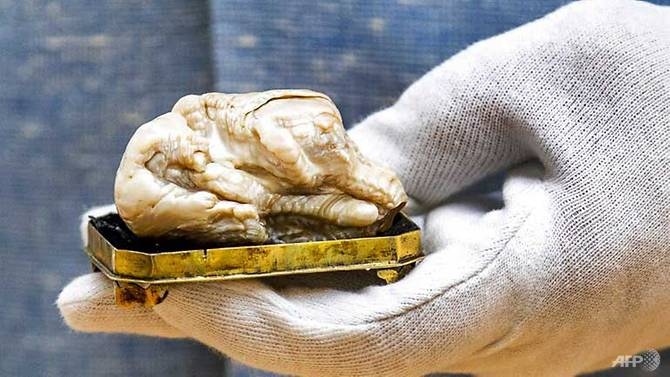World's largest freshwater pearl goes for US$374,000
 |
| File photo shows the Chinese-Dutch 'Sleeping Lion Pearl' during a viewing day at the Pulchri Studio in The Hague. (Remko de Waal/ANP/AFP) |
Known as the Sleeping Lion pearl due to its distinctive shape, the pearl was likely formed in the first half of the 18th century in Chinese waters, possibly even the Pearl River.
The auctioneers said the jewel weighs some 120 grammes and is almost seven centimetres long making it one of the three largest known pearls in the world.
The pearl, bought by a Japanese trader for €320,000, had been valued €340,000 and €540,000.
Around 1765, the pearl was shipped to Batavia, now known as Jakarta, by a Dutch merchant of the United East Indies Company. It was there that it came into ownership of the company's accountant, Hendrik Coenraad Sander.
"After Sander passed away, the pearl was auctioned off in Amsterdam in 1778 and acquired by Catherine the Great, Empress of Russia," the auction house had said.
Catherine had the pearl displayed in the Hermitage in St Petersburg until 1796. In the turbulent years that followed her death, the pearl vanished and ultimately surfaced again in Poland.
After more adventures, it was bought in 1865 by a Dutch goldsmith and remained in his family's possession for four generations, before the "Amsterdam Pearl Society bought the pearl in 1979 intending to research it and trace its history," the auctioneers said.
What the stars mean:
★ Poor ★ ★ Promising ★★★ Good ★★★★ Very good ★★★★★ Exceptional
Related Contents
Latest News
More News
- Free tickets, Lunar New Year promotions on offer at Vietjet Mega Livestream (November 26, 2025 | 15:32)
- UNIQLO unveils upgraded heat-retention wear at Hanoi event (October 26, 2025 | 10:00)
- Vietnam named among world’s top four culinary destinations (October 24, 2025 | 17:09)
- Vietnam and Denmark strengthen dialogue on sustainable fashion (October 20, 2025 | 09:11)
- Fusion rolls out special initiatives to celebrate Vietnamese Women’s Day (October 17, 2025 | 20:00)
- Showcase AC 2025 set to light up Hanoi stage (September 12, 2025 | 18:06)
- Hotel Indigo Saigon The City hosts event to reimagine city’s beloved alleyways (July 23, 2025 | 17:04)
- UNIQLO’s sustainability strategy behind the brand's global growth (June 23, 2025 | 15:42)
- Vietnam International Travel Mart 2025 kicks-off in Hanoi (April 10, 2025 | 17:50)
- Phu Quoc named as one of Asia's 'Best Islands' (March 13, 2025 | 10:24)

 Tag:
Tag:





















 Mobile Version
Mobile Version